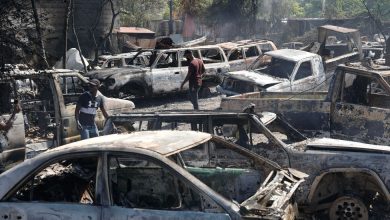A Flight Over China in Clear Skies, Followed by a Nosedive

BEIJING — China Eastern Airlines Flight 5735 was at 29,100 feet in clear afternoon skies over the hills of southern China, seemingly ready for a smooth landing in Guangzhou. The plane, a Boeing 737-800 NG, was only seven years old. One of China’s most experienced aviators was among the three pilots in the cockpit.
But then, at 2:20 p.m. on March 21, the aircraft plummeted.
Air traffic controllers made frantic calls that went unanswered. The pilots sent no mayday messages. The plane fell more than 20,000 feet in less than a minute, to 7,400 feet. Then it gained 1,200 feet of altitude in about 15 seconds, before a final plunge into a hillside covered in bamboo groves and banana trees. The plane was almost exactly vertical and approaching the speed of sound as it tore into the soft earth, with pieces of the aircraft driving as deep as 60 feet into the mud. Two pieces of a wingtip landed seven miles away.
Investigators, including a seven-member team from the United States that arrived Saturday, are scrambling to understand what happened in the final minutes before the plane plunged headlong, killing all 132 people onboard.
Every air crash investigation poses unique challenges. But this one, China’s worst air disaster in more than a decade, is even more of a mystery because the plane was obliterated by the extraordinarily high speed of its impact, at essentially a 90-degree angle. At the end of the search last week, rescuers said they had recovered 49,117 pieces from the wreck.
China also maintains an unusually tight grip on information, censoring discussion and speculation online and allowing only limited coverage of the disaster. Chinese officials have closely guarded much of the information about the crash. Families of the victims have been monitored to prevent them from speaking with journalists or staging any protests. The names of the pilots have not been officially released, although a state-owned newspaper in Hong Kong published them anyway.
Much hinges on what data can be recovered from the plane’s cockpit voice recorder and the data recorder. The so-called black boxes are designed to withstand crashes, but experts say the severe impact of this one may have damaged the recorders to the point that some data is lost. The flight data recorder ended up five feet underground and could only be extracted after firefighters removed a large tree root above it.
The National Transportation Safety Board in the United States was helping China download information from the cockpit voice recorder at a lab in Washington, according to Peter Knudson, a spokesman for the N.T.S.B.
The tragedy has raised questions about the country’s flight safety record in an important year for China’s top leader, Xi Jinping, who will be seeking a third term at a Communist Party congress later this year. China Eastern and its subsidiaries have grounded 223 Boeing 737-800 jets for safety checks, a third of their overall fleet. The Politburo Standing Committee, the country’s top ruling body, said at a meeting chaired by Mr. Xi last week that officials should determine the cause of the crash as soon as possible.
Officials overseeing the search said that they had recovered some key plane components, including parts of the engines and landing gear. They were trying to recreate the plane’s flight path using data from air traffic control radars and also examining for possible clues what luggage and mail were put on the plane.
Officials have pledged to release preliminary conclusions within 30 days of the crash, in line with timetables set out by the Convention on International Civil Aviation, a global agreement. That agreement also calls for the participation of representatives from the aircraft manufacturer and the transportation safety regulator from the manufacturer’s home country. A team of investigators from the N.T.S.B. and Boeing arrived in China on Saturday, though it was unclear if they had to complete 14 days or more of coronavirus quarantine in the country before starting work.
State media reports about the crash so far have been limited. A division of Jinan Daily, a state-owned publication from a city 1,000 miles from the crash site, published interviews with one farmer near the crash site who described seeing black smoke coming from the aircraft and with another farmer who described seeing white smoke. A surveillance camera at a distant mine recorded the final seconds of the plane’s vertical descent. Those images did not show any smoke at all.
“Nothing really seems to make sense with this one,” said Peter Marosszeky, a semiretired airline executive engineer and Boeing technical adviser who is now the managing director of Aerospace Developments, a Sydney research and development company. Black smoke would suggest burning fuel while white vapors could be leaking fuel, but eyewitness accounts are very often unreliable in crash investigations, he added.
Air crash experts typically study the details that trickle out from a crash investigation for signs of a midair collision or explosion, mechanical problems aboard the aircraft or pilot suicide. Practically all of the plane crashed in one place, reducing the odds that a terrorist bombing or other high-altitude mishap took place, experts said. No residues of explosives had been found on the debris, according to Zheng Xi, the fire chief of the Guangxi region, where the crash occurred.
The discovery by a farmer of a piece of the plane seven miles west from the crash site had initially raised speculation among experts that the plane suffered some kind of a midair breakup. But Chinese authorities later confirmed that the fragment plus a much smaller fragment found a mile away were pieces of one of the aircraft’s winglets, which are wing tip extensions that produce extra lift. Air crash experts said it was not surprising that such lightweight parts might land far from the site.
“It’s a winglet, so it’s going to fly like a wind — it’s not going to come down like a hunk of aluminum, it’s going to fly around,” said John Goglia, a retired board member of the N.T.S.B. who has worked on air crash investigations around the world for more than half a century.
The Latest on China: Key Things to Know
Marriages and divorces. Faced with a soaring divorce rate, China introduced a rule forcing married couples to undergo a 30-day “cooling off” period before formally parting ways. The move seems to have been effective at reducing divorces, but is unlikely to help with a demographic crisis fueled by a decline in marriages.
China Eastern Airlines crash. Emergency workers found no survivors after a Boeing 737 plane carrying 132 people crashed in the southern region of Guangxi. The crash of China Eastern Airlines Flight 5735 is the country’s worst air disaster in more than a decade.
The war in Ukraine. Despite calls from other world leaders for China to play a more proactive role in pressing Russia to negotiate an end to the war, Beijing has instead tried to keep its distance. The result has left China, diplomatically, on the sidelines of the conflict.
Omicron surge. As China grapples with its worst Covid-19 outbreak since the beginning of the pandemic, Beijing is trying to fine-tune its “zero Covid” playbook, ordering officials to quash outbreaks but also find ways to limit the economic pain involved.
Damage to a winglet or the loss of a winglet would not cause a big change to a pilot’s ability to stay airborne, Mr. Goglia added. “It wouldn’t cause a nosedive, and it is possible it broke off as the plane approached supersonic speeds” during its descent, he said.
Aviation Partners Boeing, a Boeing joint venture with a wingtips manufacturer that makes winglets for the 737-800, declined to comment on the discovery of the winglet fragments.
Aviation experts including Mr. Goglia have focused in particular on the aircraft’s vertical position at impact. Commercial aircraft are designed so that their natural tendency is to level off in flight. Achieving a true nosedive requires constant, extreme force on the horizontal stabilizers on either side of the aircraft’s tail, Mr. Marosszeky said.
The horizontal stabilizers control a plane’s pitch — whether the front of the plane tends to go up or down. The question to experts is whether the nose of the plane was pushed down because of a technical malfunction or because of a pilot’s decision.
Martin Craigs, the chairman of the Aerospace Forum Asia, a Hong Kong-based trade group for aviation equipment suppliers, said that in the China Eastern crash, the ability of the plane to fly almost perfectly straight down, without gliding or fluttering, helps show that, “it’s clearly not a terrorist bomb.” But he did not rule out a deliberate crash.
He pointed to the 2015 crash of a Germanwings flight carrying 150 people as an example of a pilot suicide. “Nothing should be ruled out — remember, we had a pilot deliberately fly a plane into the Alps a few years ago.”
Amy Chang Chien and Li You contributed research.




